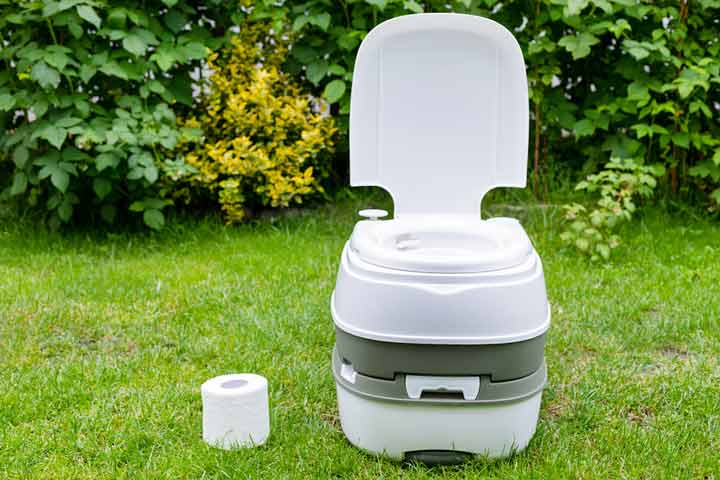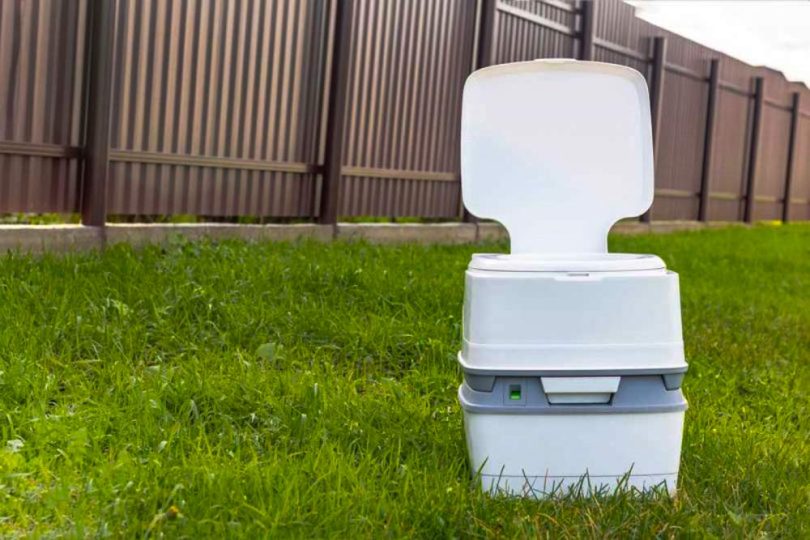Now campers can take their portable toilet to the unserviced or dry campgrounds, and not worry about finding a place for setting a tent that has to be near a public RV toilet.
They are easy to use and light in weight to carry in an RV or motorhomes. Since camping toilets need less water for flushing and the human waste is not dumped in any random place, makes it an excellent option as a travel essential.
However, they need to be properly maintained in an eco-friendly way. The porta-potty’s plastic materials can get damaged easily or it can cause harm to the environment if the waste is not deposited in the right manner. So you need to know how a camping toilet work and how to empty and clean them.
How Does a Camping Toilet Work?

A portable toilet has 4 basic parts;
- Toilet seat
- Flush
- A holding tank or waste tank
- A pressure system
Like any conventional home toilet, a portable toilet has a toilet seat and flush mechanism. But in the case of a porta-potty, the waste goes down to a waste tank or a holding tank instead of the sewer.
There is a hidden water tank containing the water or chemical used for flushing. The flush system is connected to a pump that creates pressure for water to flow down through a pipe to the toilet pen.
The toilet seat sits on top of the portable holding tank. It holds all the flushed water, waste, and other toilet chemicals which you will have to empty by yourself.
Before Using the Portable Toilet
You have to secure the water tank and waste tank together before you use the toilet.
Use a deodorant as a sanitizer to disinfect the porta-potty. You can buy them or some manufacturers provide them with the purchase. These deodorants are powerful toilet cleaning products that come in both liquid and powder forms. Each bottle contains a liquid or powder product that can clean about 40 gallons.
So you need to drop a small amount of the chemical in the waste tank.
Now, pump water in the water tank and flush to activate the deodorant. Make sure the chemical reaches every corner of the porta-potty. After this, close the water tank to use the toilet.
Important Reminders in Using a Portable Toilet
- A standard portable toilet can hold 3 to 4 gallons of waste. Do not overflow your waste tank with water beforehand
- Use only a small amount of deodorant powder or liquid sanitizer according to the waste tank size. A bottle of deodorant powder can go for a long time
- To avoid dirty splashes, set the toilet at a 90° angle or in a sitting position
- Use trash bags to throw the used toilet papers away so that toilet papers do not take extra space in the waste tank
- Keep the chemicals out of children’s reach as they are a very strong chemical that can cause serious damage
- If the camping toilet won’t be used for a long time, then always empty the water tank. Otherwise, water inside might freeze and damage the toilet tank. Use anti-freeze during the cold weather
Before Emptying a Portable Toilet
Human waste contains germs and bacteria which cannot be disinfected completely with a deodorant or toilet sanitizer. Therefore you should never empty a portable toilet on a water or ground surface.
You also have to know when to empty your porta potty. Whenever the waste tank is full, empty it. You should empty it as often as possible, as you don’t want to carry the waste everywhere you go.
If there is a local septic tank near you, you can empty the waste tank there. You can also dump the waste in an RV dumping station.
How to Empty a Portable Toilet?
-
Close The Valve
Close the valve before you take the porta-potty out to emptying. Otherwise, there will be unwanted splashes of poop water everywhere.
If you are in the group, inform them beforehand that they won’t be able to use the toilet for a good 20 to 30 minutes.
-
Remove Cassette From Motorhome
Put on gloves for emptying and cleaning the cassette toilet. You can locate the holding tank outside of your motorhome. Now open the lock and remove the cassette by pulling it out of the holding tank. The cassette should have a handle to grab the waste tank out effortlessly. Your motorhome tank holding window will also have instructions on how to remove the cassette.
-
Empty Cassette at the Chemical Disposal Point
Arrive at a chemical disposal point and look for the WC sign. There you will find the disposal drain to empty the waste tank.
Now place the cassette directly on the drain to empty it. Tip the cassette over the drain and press the ventilation button as you do so.
If you do not have any unwanted splash, then keep the ventilation button pressed till the whole cassette is empty.
-
Clean the Empty Cassette
After emptying the cassette, take the waste tank to the nearest clean water source. Pump water through the tube that is attached to the cassette to hose down any remaining waste. Close the tube opening and give it a good shake or roll the cassette on the ground so that any buildup waste is cleared out.
After that empty the cassette again and repeat the process 2 to 3 times to draw out all the waste inside the cassette.
-
Restock Chemicals & Return Cassette
Before returning the cassette to the motorhome tank, you need to add deodorant or sanitary additives to the waste tank.
Pour some water inside of the cassette and a small number of chemicals in liquid or powder form. They keep the cassette odor-free and do not allow any build-up at the bottom of the tank. These kinds of chemicals are strong and should be kept out of children’s and animals’ reach.
Some eco-friendly sanitary additives do not spread toxicity in the environment. Read the levels and buy products that do not contain formaldehyde.
After cleaning and restocking all the essentials, put back the cassette in the motorhome compartment. Secure the tank in place and lock the window.
Now you are ready to use the cassette all over again.
FAQs
1. How to know when my cassette toilet is full?
Ans. Some cassette toilets come with a waste tank level indicator. It is a flush button that turns red when the tank is full. Other cassette toilet models come with their water holding tank according to waste tank size. The water holding tank holds the amount of water that the waste tank has a capacity for. So after flushing, if the water holding tank is empty, then you know you have to empty the cassette.
However, you should clean your cassette once every 2 days to keep it clean and odor-free even if you don’t use it as often.
2. Can I use toilet paper in a cassette toilet?
Ans. Although you can use toilet paper in the cassette toilet, we recommend throwing the used toilet paper in a trash bag. Because the toilet papers can build up at the bottom of the waste tank and get stuck. This can cause odor, grow bacteria on them, plus the cleaning process is disgusting. So you should opt from flushing toilet paper in the cassette.
Moreover, flushing the toilet paper in the waste tank will take extra space for the waste tank. So toss them in a polybag and later empty it with the cassette in a disposal point.
You can also use special cassette toilet paper that easily breaks down with water. So they can be flushed down the cassette and they won’t make any kind of clogging.
3. How do I stop my portable toilet from smelling?
Ans. There are 2 ways to stop your camping toilet from smelling; use chemical products and clean the waste tank regularly.
Use cleaning tablets, deodorants, or diffusers to keep the porta-potty from smelling. They will keep the overwhelming odor in check. Drop a cleaning tablet or a liquid or powder deodorant in the water tank to get rid of the toilet smell.
Empty and clean your camping toilet regularly. Maintaining hygiene will help to keep your motorhome or travel van toilet fresh.
You can also buy an air freshener or make an air diffuser with essential oils to eradicate bad smells from your travel van.








Leave a Comment